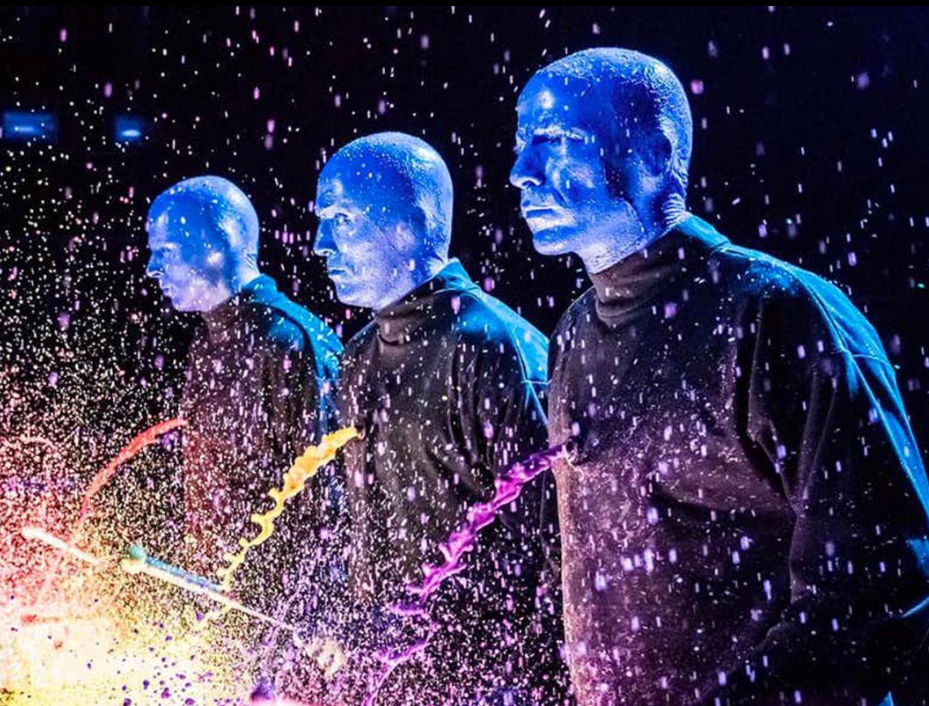After more than three decades of electrifying performances, the Blue Man Group is saying goodbye to its hometown of New York City. On Sunday, the pioneering performance art ensemble will take the stage for the last time at the Astor Place Theatre, marking the end of an era for one of the city’s most unique and beloved shows. The sold-out event serves as a grand finale to over 17,000 performances in New York, where an ever-evolving troupe of bald, blue-painted performers has captivated audiences with their wordless, rhythmic, and often surreal antics since 1991.
While the show will continue in other locations, its departure from New York raises questions about the sustainability of live theater in a post-pandemic world. Let’s take a closer look at the Blue Man Group’s origins, rise to fame, and what this closure signifies for the broader performance industry.
A Legacy of Quirk and Innovation
The Blue Man Group was born in New York City’s experimental art scene in the late 1980s. Founders Chris Wink, Phil Stanton, and Matt Goldman wanted to create a performance that defied convention—something that combined music, movement, and interactive elements in ways traditional theater did not. The result was a wordless, eccentric, and visually stimulating act that relied on expressive physical comedy, drumming, and innovative prop use (like painting with their mouths or drumming on PVC pipes splattered with neon paint).
What began as a small, underground performance quickly grew into an international phenomenon. By 1991, the group had secured a permanent home at the Astor Place Theatre in Manhattan’s East Village, where it became a staple of the city’s entertainment scene. The Blue Man Group’s success hinged on its ability to blend performance art with high-energy music and humor, creating an experience that was accessible and enjoyable for audiences of all ages and backgrounds.
Pop Culture Fame and Global Expansion
Over the years, the Blue Man Group became a household name, thanks in part to high-profile appearances on television and extensive touring. The group made 17 appearances on The Tonight Show with Jay Leno, introducing their distinctive brand of silent comedy and percussive music to millions of viewers. Their mainstream popularity was further boosted by commercials, music collaborations, and guest spots on shows like Arrested Development and Scrubs.
As their notoriety grew, so did their presence. Beyond New York, the Blue Man Group established long-running productions in other major cities, including:
•Chicago – A permanent show ran for 26 years before closing in January 2024.
•Las Vegas – A still-operational production at the Luxor Hotel.
•Boston – A long-standing run continues at the Charles Playhouse.
•Berlin – A European iteration still welcomes audiences.
•Orlando – A revival is in development after a previous closure in 2021.
Their touring company also brought the Blue Men to countless cities around the world, ensuring that audiences far beyond New York could witness their signature mix of avant-garde performance art and absurdist humor.
The Cirque du Soleil Era and Financial Troubles
In 2017, the Blue Man Group was acquired by Cirque du Soleil, the renowned Montreal-based circus company. The acquisition was meant to help the act expand further and integrate into Cirque’s global brand, known for its acrobatic spectacles and immersive theatrical productions. However, the COVID-19 pandemic dealt a severe blow to Cirque du Soleil and the live entertainment industry as a whole.
Cirque du Soleil filed for bankruptcy in 2020, citing the inability to put on shows and the financial devastation caused by worldwide lockdowns. While the company later restructured under private equity ownership, its priorities shifted, and some productions—such as Blue Man Group’s NYC and Chicago shows—were deemed financially unsustainable.
The challenges facing Blue Man Group in its home city reflect larger issues within live theater and performance art.
Why Is Blue Man Group Leaving New York?
The decision to close the NYC production isn’t just about Blue Man Group itself—it’s part of a broader struggle within the live theater industry. Several factors contributed to its closure:
Rising Production Costs
Running a long-term theater production in New York City has become increasingly expensive. Between rent, salaries, marketing, and technical upkeep, costs have ballooned in the past decade. Many Off-Broadway shows, like Blue Man Group, operate with smaller margins compared to Broadway juggernauts, making it difficult to maintain profitability.
Shifting Audience Trends
While New York City remains a hub for theater, audience habits have changed, especially post-pandemic. Tourists—who make up a significant portion of theatergoers—haven’t fully returned in pre-pandemic numbers, and local audiences have more entertainment options, from streaming services to immersive digital experiences.
Post-Pandemic Recovery Challenges
Broadway and Off-Broadway productions have struggled to regain their pre-2020 attendance levels. While blockbuster shows like Hamilton and The Lion King still draw large crowds, smaller, more niche productions like Blue Man Group have found it harder to fill seats consistently.
Corporate Restructuring by Cirque du Soleil
Cirque du Soleil’s financial troubles meant reassessing its portfolio, and unfortunately, Blue Man Group’s NYC show didn’t make the cut. By closing underperforming or expensive productions, Cirque hopes to focus on more profitable endeavors.
The Future of Blue Man Group
Despite the NYC closure, the Blue Man Group isn’t disappearing altogether. Fans can still catch performances in Boston, Las Vegas, Berlin, and in the upcoming Orlando reboot. The show’s format, which relies on a rotating cast of performers, allows it to be adapted to different locations and markets.
However, losing its NYC home is a significant shift. The Astor Place Theatre wasn’t just a venue—it was the birthplace of the show’s success and a symbol of its legacy in the city’s avant-garde theater scene. Without it, Blue Man Group loses a key piece of its identity.
Big Picture: The State of Live Theater
The closure of Blue Man Group’s New York and Chicago productions is part of a wider challenge facing the live performance industry. Even Broadway, despite its massive cultural footprint, has struggled with ticket sales and profitability in recent years. Several big-name shows, including The Phantom of the Opera and Beetlejuice, have closed, reflecting the industry’s ongoing struggles.
The End of an Era, But Not the End of Blue Man Group
The final performance of Blue Man Group in New York City is a bittersweet moment. It marks the end of a beloved institution that has entertained millions and helped redefine the possibilities of live performance. While the group’s journey will continue elsewhere, its departure from NYC is a reminder of the ongoing challenges facing theater in an evolving entertainment landscape.
For those lucky enough to attend the sold-out final show, it will be a historic moment—a last chance to witness the blue-painted trio drumming, dancing, and delighting audiences in the city where it all began. But for fans around the world, the spirit of Blue Man Group will live on, even if its original home no longer does.
No comments yet.








